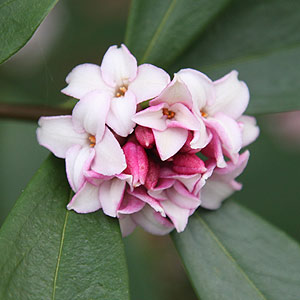The Winter Flowering Daphne

Perhaps the most widely grown species, Daphne odora is a winter flowering plant grown form the fragrant flowers that cover the plant until spring.
A small rounded shrub with pink or white flowers Daphne odora also has good foliage and is easy care in a part shaded position. Available in a number of varieties including variegated leaf forms this is a plant that requires a little pruning to maintain a healthy bushy habit. Although it is slow growing, it is a long lived plant given the right growing conditions.
Growing well in USDA zones 7 – 9, D. odora can also be grown in a container if required which will help with overwintering if needed.
As for fragrance, we consider this to be the best of all of the Daphnes, it may not have flowers for as a long as some, however the perfume is better and stronger.
Daphne Odora Care
With a bit of a reputation as being hard to grow, D. Odora is actually easy in the right position. Many Daphne species have an unwarranted reputation as being difficult. However if you follow a few basic rules you will find them trouble free and long lived.
The idea that Daphnes like shade and moist soils is a little misleading, not only is it simply not true for all species, they differ. It is also wrong for Daphne odora, so look at our top tips for a healthy Daphne plant.
Choose a position in part shade and prepare the soil by digging in some well rotted compost and aged cow or sheep manure. Plant and water water in well with a liquid seaweed fertilizer. Leave the plant alone.
Top Tips
- Part Shade, good morning sun and good protection from hot afternoon sun.
- A well drained soil, Daphne odora does like moisture, however constantly wet soil will kill them.
- Mulch well to maintain a cool root run.
- Do not be tempted to move established plants unless absolutely necessary, like most species, this one resents being disturbed.
Daphne Odora Varieties
- D. odora ‘aureomarginata’ (syn D. odora ‘marginata’ – Narrow cream to yellow margins on the leaves
- D. odora ‘alba’, white flowers.
- D. odora var.rubra – Pinkish flowers
- Da. odora ‘Zuiko Nishiki’ – A new cultivar with a more vigorous habit
Pruning Daphne Odora
Generally pruning is said to be not required, the habit of picking a few flower sprigs for vases takes care of this for most gardeners. So ‘tip pruning’ on a regular basis works well.
Some gardeners find that plants left for many years get a little leggy and try for a ‘hard prune’. This is a difficult task and can lead to ‘sudden death’ with Daphne odora.
Our recommendation for pruning Daphne odora is ‘Don’t Prune at all’. Just pick flowers regularly from an early age and the plant will thrive.
OR
Immediately after flowering, with established plants prune back by 4 inches. It must be done as the flowers fade and you need to use judgement as to how much to prune. Anywhere from 2 – 6 inches really.
Summary Information
- Botanical Name : Daphne odora
- Common Name : Winter Daphne
- Family Name : Thymelaeaceae
- USDA Zone : 6 – 8
- Height : To around 48 inches
- Spread : To around 48 inches
- Growth Rate : Medium to slow
- Flower colour – Pink or White depending on variety
- Flowering Time – Winter to Spring depending on the zone
- Soil : Humus rich, moist and well drained
- Light : Full to part Light shade.
- Humidity : Medium
- Container Growing : Yes
- Frost Tolerance : Light to medium frosts only
- Drought Tolerant : No

